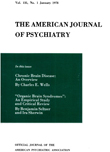PSYCHIATRIC TREATMENT OF THE CALIFORNIA FELON
Abstract
The medical objective in the psychiatric treatment of the incarcerated felon is to cure him of his psychological and social tactics that eventuate in loss of his behavioral options and then loss of control over his social stimuli and responses; or, if you will, the relearning of how to use previously unpracticed social options for initiating or responding to conversations provides the inmate with a measure of social control previously not available to him.
Two of the major advantages the so-called antisocial person gives up on cure are, 1. Playing "cops and robbers" with its attendant gratifications, and 2. The use of "go-directly-to-jail" to solve external or internal life stresses.
Access content
To read the fulltext, please use one of the options below to sign in or purchase access.- Personal login
- Institutional Login
- Sign in via OpenAthens
- Register for access
-
Please login/register if you wish to pair your device and check access availability.
Not a subscriber?
PsychiatryOnline subscription options offer access to the DSM-5 library, books, journals, CME, and patient resources. This all-in-one virtual library provides psychiatrists and mental health professionals with key resources for diagnosis, treatment, research, and professional development.
Need more help? PsychiatryOnline Customer Service may be reached by emailing [email protected] or by calling 800-368-5777 (in the U.S.) or 703-907-7322 (outside the U.S.).



